Friday 1 December 2006
We take Underground (U-bahn) to Marienplatz
and start to walk down the Neuhauserstraße. We have coffee near the Frauenkirche,
the cathedral of Munich. We take a look at 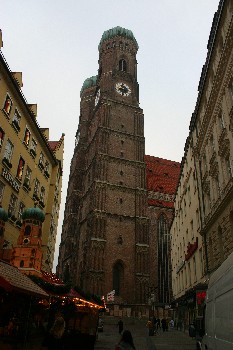 cathedral with its high nave and stained glass windows. Striking features are
the two 99 metre high towers topped with halfround onionshaped domes, that
dominate the skyline. We continue down the street and visit the Michael
church, built during the counter reformation. In 1583
duke Wilhelm V the Pious initiated the construction, which was completed in 1597.
The church is the first renaissance church North of the Alps and has the second
largest barrel ceiling in the world with a span of 20 metres. The theme of the
fighting St Michael battling for the faith is visible throughout the church. It
has a nice Choir and the crypt holds the graves of many a Bavarian duke or king
from the Wittelsbach dynasty.
cathedral with its high nave and stained glass windows. Striking features are
the two 99 metre high towers topped with halfround onionshaped domes, that
dominate the skyline. We continue down the street and visit the Michael
church, built during the counter reformation. In 1583
duke Wilhelm V the Pious initiated the construction, which was completed in 1597.
The church is the first renaissance church North of the Alps and has the second
largest barrel ceiling in the world with a span of 20 metres. The theme of the
fighting St Michael battling for the faith is visible throughout the church. It
has a nice Choir and the crypt holds the graves of many a Bavarian duke or king
from the Wittelsbach dynasty. 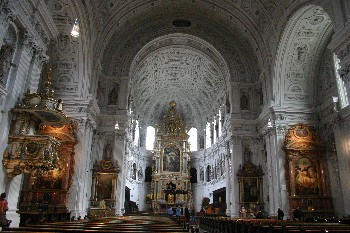 On Karsplatz (also named Stachus) near the Karl gate there is an
ice rink, where there is normally a fountain. The Karl gate is a city
gate originally dating back to 1391, but which has been remodeled in the late
19th century in a neo-gothic style. Here we take the U-bahn again, this time to
the museum district around Königsplatz. We start at the Propyläen, a
neoclassic construction built in the honour the recognition of Otto, son of king
Ludwig I, as the king of Greece in 1832. We walk along the likewise neoclassical Staatliche Antikensammlung
(State Antiquity collection; 1845) and the Glyptotek (1830; antiquity statues)
via the Brienerstraße to the Karolinenplatz with the obelisk. Here we
take a left into Barerstraße in the direction of the Alte
Pinakothek and Neue
Pinakothek. The Alte from 1836 has lots of old art (middle ages through 19th
century) while the Neue from 1981 covers the period
On Karsplatz (also named Stachus) near the Karl gate there is an
ice rink, where there is normally a fountain. The Karl gate is a city
gate originally dating back to 1391, but which has been remodeled in the late
19th century in a neo-gothic style. Here we take the U-bahn again, this time to
the museum district around Königsplatz. We start at the Propyläen, a
neoclassic construction built in the honour the recognition of Otto, son of king
Ludwig I, as the king of Greece in 1832. We walk along the likewise neoclassical Staatliche Antikensammlung
(State Antiquity collection; 1845) and the Glyptotek (1830; antiquity statues)
via the Brienerstraße to the Karolinenplatz with the obelisk. Here we
take a left into Barerstraße in the direction of the Alte
Pinakothek and Neue
Pinakothek. The Alte from 1836 has lots of old art (middle ages through 19th
century) while the Neue from 1981 covers the period 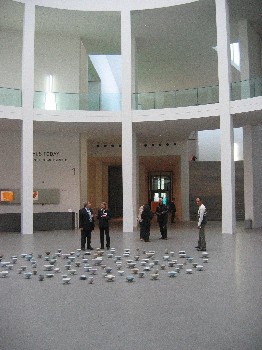 1800-1920. We visit the Pinakotek
der Moderne. The building from 2002 offers a modern collection and
special exhibitions. This time it has a retrospective of the light artist Dan Flavin.
Beside that there is a lot of applied art en design. After the museum visit we
take the U-bahn to the Schwabing district where we have lunch in an Italian
restaurant.
1800-1920. We visit the Pinakotek
der Moderne. The building from 2002 offers a modern collection and
special exhibitions. This time it has a retrospective of the light artist Dan Flavin.
Beside that there is a lot of applied art en design. After the museum visit we
take the U-bahn to the Schwabing district where we have lunch in an Italian
restaurant.
Later in the afternoon we take the
regional S-bahn to Dachau. There we visit the KZ-gedenkstätte,
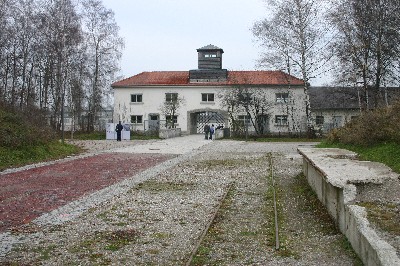 or the memorial to the concentration camp of Dachau. The main building and some
of the barracks are what is left of this concentration camp that saw over
200.000 inmates who underwent forced labour, torture, medical experiments,
famine and many of whom succumbed to the attrocities. The camp started out in
1933 as facility for members of the opposition groups, who were taken into
"preventive custody". The poor village of Dachau welcomed the camp
which offered jobs, both in the camp as outside at supplying companies. Although
it was not a destruction camp - the gas chambers were never put to use - the
conditions for the prisoners (social Democrats,
or the memorial to the concentration camp of Dachau. The main building and some
of the barracks are what is left of this concentration camp that saw over
200.000 inmates who underwent forced labour, torture, medical experiments,
famine and many of whom succumbed to the attrocities. The camp started out in
1933 as facility for members of the opposition groups, who were taken into
"preventive custody". The poor village of Dachau welcomed the camp
which offered jobs, both in the camp as outside at supplying companies. Although
it was not a destruction camp - the gas chambers were never put to use - the
conditions for the prisoners (social Democrats,
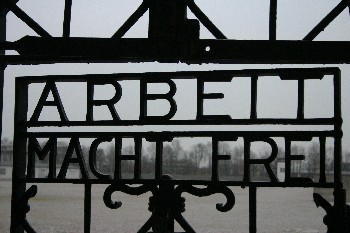 communists, gypsies, gays, Russians, Poles, Jews and many others) were
horrible. Even after the liberation by the US army in April 1945 people still
died from the effects of the maltreatment. There is an exhibition on the
history of the camp in the main building. It also gives the context of the rise
of the Nazi's and the Second World War that followed. It shows a nasty picture
of the only camp that served throughout the Nazi era from 1933 until 1945. After
the war the camp was used as a refugee camp for displaced persons from Eastern
Europe. This prevented the locals from coming to terms with the real
significance of the camp. Not before 1964 the last of its inhabitants moved on
and part of the camp became a memorial and musueum. The memorial was redeveloped
between 1997 and 2003 and the exhibition got a new lay out. The website
offers a virtual guided tour.
communists, gypsies, gays, Russians, Poles, Jews and many others) were
horrible. Even after the liberation by the US army in April 1945 people still
died from the effects of the maltreatment. There is an exhibition on the
history of the camp in the main building. It also gives the context of the rise
of the Nazi's and the Second World War that followed. It shows a nasty picture
of the only camp that served throughout the Nazi era from 1933 until 1945. After
the war the camp was used as a refugee camp for displaced persons from Eastern
Europe. This prevented the locals from coming to terms with the real
significance of the camp. Not before 1964 the last of its inhabitants moved on
and part of the camp became a memorial and musueum. The memorial was redeveloped
between 1997 and 2003 and the exhibition got a new lay out. The website
offers a virtual guided tour.
Back in town we arrive at Marienplatz,
where the Christkinlmarkt (Christmas market) is about to be officially opened.
It very busy. That's why we go directly to the 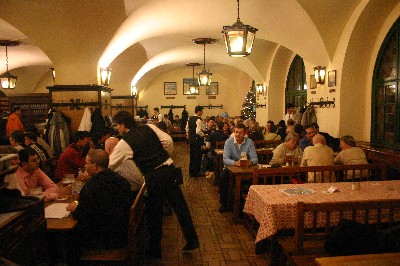 Hofbräuhaus
to indulge in the typical Bavarian tradition of the Biergarten (Beer Garden) or
Bierkeller (Beer Cellar). The Hofbräuhaus is the most famous of the lot,
especially among tourists. It can hold over a 1,000 people at any one time.
Drinking beer is the main draw. It comes by the litre (1,76 UK Pints or 2,11 US
Pints), only the Weißbier (White Beer) comes in glasses half that size. The
place gets lots of tourist, but also many Bavarians, especially on Fridays, when
many tables are reserved for so called Stammtische or drinking clubs. The
members (all male) come all dressed up their traditional leather costumes and
feathered hats to celebrate their weekly beer binge. After 6pm a Bavarian band
starts contributing to the fun. It is a noisy, and a bit tacky form of
amusement, but interesting nonetheless and quite bearable for an hour or
so.
Hofbräuhaus
to indulge in the typical Bavarian tradition of the Biergarten (Beer Garden) or
Bierkeller (Beer Cellar). The Hofbräuhaus is the most famous of the lot,
especially among tourists. It can hold over a 1,000 people at any one time.
Drinking beer is the main draw. It comes by the litre (1,76 UK Pints or 2,11 US
Pints), only the Weißbier (White Beer) comes in glasses half that size. The
place gets lots of tourist, but also many Bavarians, especially on Fridays, when
many tables are reserved for so called Stammtische or drinking clubs. The
members (all male) come all dressed up their traditional leather costumes and
feathered hats to celebrate their weekly beer binge. After 6pm a Bavarian band
starts contributing to the fun. It is a noisy, and a bit tacky form of
amusement, but interesting nonetheless and quite bearable for an hour or
so.
We retreat to the hotel for a bit before we go for dinner at Selig in the
gay triangle near the Sendling Gate. After that we explore the gay scene a
bit further.
Saturday 2 December 2006
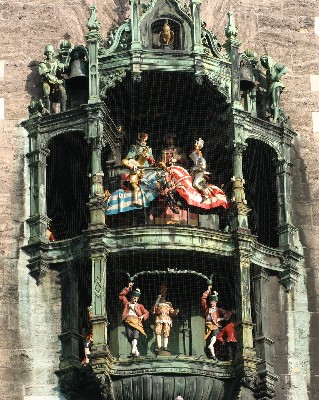 We
start with coffee near the hotel and then go downtown for some shopping. The Marienplatz
and the Neuhauserstraße are filled to capacity. At 11am Town Hall glockenspiel
starts to play. A beautiful spectacle that we had not have the opportunity to
watch until now. It shows the wedding of duke Wilhelm V to Renata von Lotharingen in
1568, including the tournament that took place on Marienplatz on that occasion.
The lower part of the glockenspiel shows the Schäfferltanz (cooper dance). The
glockenspiel is the world's fifth largest and first sounded in 1908. It is
extremely busy on the square, where the admirers of the glockenspiel, the
visitors of the Christmas market and the Saturday shoppers fight for space. We
do some shopping in various shops and department stores before sit down at café
Stacherias on Karlsplatz. We
start with coffee near the hotel and then go downtown for some shopping. The Marienplatz
and the Neuhauserstraße are filled to capacity. At 11am Town Hall glockenspiel
starts to play. A beautiful spectacle that we had not have the opportunity to
watch until now. It shows the wedding of duke Wilhelm V to Renata von Lotharingen in
1568, including the tournament that took place on Marienplatz on that occasion.
The lower part of the glockenspiel shows the Schäfferltanz (cooper dance). The
glockenspiel is the world's fifth largest and first sounded in 1908. It is
extremely busy on the square, where the admirers of the glockenspiel, the
visitors of the Christmas market and the Saturday shoppers fight for space. We
do some shopping in various shops and department stores before sit down at café
Stacherias on Karlsplatz.
After a while we take the U-bahn to Sendlinger Tor
and have some lunch at Kraftakt. We take the tram back to the hotel to fetch our
baggage. By now it is time to take the S-bahn to the airport. We take S-8 and
get there within 40 minutes. We have again checked in through Internet. The
printing of the boarding pass goes much smoother now, now we got the hang of the
thing and know what watch out for. We also check the suitcases automatically. At
5pm we take off in a smallish aircraft and a handful of passengers for
Amsterdam. We get there by 6.15pm and take the 6.43 train service back to
Rotterdam.
|